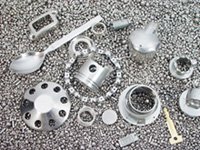Cleaning Glass Mold in an Automatic Machine
Q. I am looking for a Non-Caustic, Low Foam cleaning agent, preferrably in aqueous solution to be applied in an automatic in-line glass cleaning molds washer machine, 100 psi spray nozzels, 150F, 8 minutes total cleaning-rinse-dry cycle time, running 10 hours a day continuous; our application is for manufacturing of optical components. Glass molds we are cleaning in this washer machine have traces of cured acrilic monomer only, but must be tottaly cleaned with out damages (scratches per chemmical attac) over the critical side.
A. Citrajet is a non-caustic, non-foaming (at elevated temperatures) detergent that is suitable for use in an inline washer. Citrajet is a mild citric acid based cleaner that will etch much less than a caustic cleaner would.
Cleaning Aluminum without Corrosion
Q. How is galvanic corrosion prevented when cleaning aluminum?
A. Aluminum is an active metal that is somewhat high on the “anodic index” of the galvanic series. If aluminum is cleaned with other metals present, you can create a battery and get galvanic corrosion. Aluminum should not be cleaned in the presence of metals that are significantly higher or lower on the anodic series; higher on the anodic scale such as zinc, magnesium or beryllium metals and lower on the anodic scale such as tin, brass, bronze, copper, silver, nickel and rhodium.
Cleaning Aluminum with Alconox
Q. Which Alconox cleaners can be used on Aluminum?
A. The Alconox brand cleaners recommended for cleaning aluminum are Alconox, Liquinox, Tergazyme, Alcojet, Alcotabs, Detojet, Citranox, Luminox, Citrajet, Solujet and Tergajet. Detergent 8 is not recommended for cleaning aluminum. Aluminum forms a natural passive layer in air that allows it to be successfully cleaned without adverse reactions with cleaner. A passive layer forms in under an hour, provided there is no oily film present. Once the passive layer is formed, the recommended Alconox brand cleaners can be used to clean the aluminum at concentrations of less than 5% at 90 deg C or less for up to one hour.
Stripping NiCr-AG-NiCr Coating
Q. To strip NiCr-Ag-NiCr coating, I was preparing a solution @4% of Cerium Ammonium Nitrate (C.A.N.)and I added Citrajet @1% to be used as a wetting agent (surface inclined). The addition of Citrajet neutralized completely the effect of the C.A.N; which did not attack the NiCr layers. Can you give me some explanation and which Alconox product I have to use as wetting agent.
A. CAN is a very strong oxidizing agent. Organic functional groups with double bonds, alcohols, benzene rings and ethers are likely to be oxidized by CAN, thereby “neutralizing,” or depleting it, thereby rendering it less effective for stripping coatings. Most wetting agents have organic functional groups that will be oxidized by CAN, including Citrajet.
Electronics Cleaning – Kovar
Q. What is Kovar? What cleaner would be recommended to clean Kovar?
A. Kovar is made up of 29% nickel, 17% cobalt, .2% silicon, .3% manganese and 53.5% iron. Kovar is known for its low coefficient of thermal expansion. Kovar end uses are usually glass sealing in the electronics industry.



